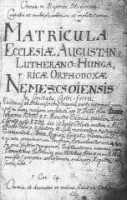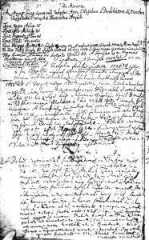Information about a particular congregation is often found mixed into the various church registers. It is sometimes found at the beginning of a register, sometimes at the end, occasionally in the form of short notes intersperced with the vital records themselves. It may be labeled "Pro Memoria" (essentially meaning "for the record") or it may be unlabeled. The format is very individual and often personal.
Shown here are the cover page of a Lutheran church register -- typical of registers from the early 18th century -- and a general Lutheran congregation history embedded in a list of pastors.
This example has a legibility problem that needs some explanation. See note below.
Lutheran Church Register.
A cover page obviously cannot contain too much information -- its purpose is primarily ornamental. But, it can give you a feeling for the time and place ... plus a few key facts that may be of use.
This example, in Latin like most, dates from 1701 and is fairly typical of church registers. The large print reads The Register of the Hungarian Orthodox Lutheran Church of the Augsberg [Confession] in the town of Nemescsó in Vas County (literally "Iron Castle County"). The new pastor, John Asboth, then introduces himself, gives the date of his assumption of the pastorate (June 19, 1701), and identifies his church superintendant, Michael Fabri of the Royal Free City of Güns (the German name for Köszeg).
He then notes that this town (Nemescsó) is an articulated place and lists the contents of the register including the names of the parents, godparents, and witnesses to baptisms. As is usual, he ends with a Bible verse, in this case quite appropriately: "All things should be done decently and in order." from 1 Corinthians 14.
Lutheran Church History.
Why is VADOSFA so important to Hungarian Lutherans?
|
- In order to assess the importance and probable accuracy of historical information, it can be important to identify who wrote the information and when.

- The most common content of separate historical notes -- especially in Protestant churches -- is a list of pastors. Lists of teachers are much less frequent. This Vadosfa congregational history is a part of a heavily annotated list of pastors.
 For further information about church staff and their identification, see the examples provided of Lists of Congregational Staff.
For further information about church staff and their identification, see the examples provided of Lists of Congregational Staff.
- Sometimes there is also information about the history of the congregation, beyond information about the clergymen. This would most often refer to construction of a new church edifice or other major changes in the congregational facilities. Less frequently this is also information about issues in the congregational life or about satellite congregations. In this Vadosfa record we see examples of all of these.

- These Vadosfa registers are a treasure-trove of other information of potential historical importance -- beyond the short historical note seen here. But, understand that Vadosfa was not a typical Lutheran congregation and one might expect more historical information to be found here. Yet, important information may crop-up in any church's registers, so keep an eye out for history hiding between baptisms or burials.






